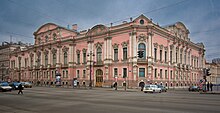Beloselsky Belozersky Palace
The Beloselsky-Belozersky Palace ( Russian Дворец Белосельских-Белозерских ) is a palace in Saint Petersburg in Russia .
The building now houses the Museum for the Development of Democracy in Modern Russia, as well as offices for authorities and companies. Concerts are also held in the house.
location
It is located at 41 Nevsky Prospect at the confluence of the street flanking the Fontanka on its eastern bank with Nevsky Prospect . Immediately to the west of the palace, the Anichkov Bridge spans the Fontanka.
Architecture and history
A first palace on this site was built for Mikhail Andreevich Beloselsky in 1747 . The French-style building was smaller than today's palace and had a large garden. Alexander Mikhailovich Belosselski inherited the palace and acquired a large piece of land in 1800. In 1800 he acquired the old title Belosersk again, since then the double name Beloselski-Belozersky was in use for the family and the palace. The palace then went to Esper Alexandrovich Beloselsky-Belosersky , who died at a young age, so that his widow Jelena Pavlovna Beloselskaya-Beloserskaya became the owner.
Under Elena Pavlova, the old palace was demolished and rebuilt in its current design between the 1840s and 1848. The architect of the palace was Andrei Iwanowitsch Stackenschneider . He designed the building in the neo-baroque style . The facade of the building is characterized by white columns with capitals. Konstantin Esperowitsch Belosselski-Beloserski , the son of Elena Pavlova, inherited the residence and lived there with his family. The size of the palace and the associated cost of maintenance proved to be a great burden on the family, so it was sold.
In 1884 the palace was built by Alexander III. given to his brother, Grand Duke Sergei Alexandrovich Romanov, for his wedding to Yelisaveta Fyodorovna . The Grand Duke gave the facade of the palace the red color that is still characteristic of the house today. He also had major renovations carried out inside. A library and a chapel were added. After the Grand Duke fell victim to a bomb attack in 1905, the palace belonged to his widow. In 1909 she went to the Marfo-Mariinsky Convent as a nun and gave the palace to her nephew, Grand Duke Dmitri Pavlovich Romanov , who sold it shortly before the October Revolution .
After the revolution, the palace was nationalized. From 1920 the district committee of the CPSU was located in the house . The house was badly damaged during the Second World War and rebuilt from 1949. The interiors were renovated in 1954.
In 1991 the palace became the seat of the city cultural center. On February 28, 2012, there was a fire in the building.
literature
- TJ Lobanowa, Saint Petersburg , Jarky Gorod Publishing House, Saint Petersburg 2015, ISBN 5-9663-0029-1 , page 137.
Web links
- Beloselskij-Belozerskij-Palast In: petersburg-info.de
- Grand Duke Serge Alexandrovich of Russia's Palace Goes Up in Flames In: erhj.blogspot.de
- SV Boglachev, Beloselsky-Belozersky Palace In: encspb.ru
Individual evidence
- ↑ SV Boglachev, Beloselsky-Belozersky Palace In: encspb.ru
- ↑ Grand Duke Serge Alexandrovich of Russia's Palace Goes Up in Flames In: erhj.blogspot.de
Coordinates: 59 ° 55 ′ 58.1 ″ N , 30 ° 20 ′ 39.6 ″ E



